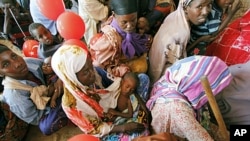A top British official says 400,000 children could die of starvation and disease in Somalia unless international agencies speed up deliveries of lifesaving food and medicines. In the capital Mogadishu, people became increasingly impatient with the slow pace of the famine response.
The children’s wards of Mogadishu’s Banadir Hospital are bursting with infants on a knife-edge between life and death.
More families with malnourished children stream in to the capital each day from rural areas in a desperate search for life-saving food and medicines.
Makeshift camps for internally displaced people are overflowing with an estimated 200,000 people surviving mainly on handouts from the local business community.
On a visit to Mogadishu this week, Britain’s international development secretary Andrew Mitchell described the world’s response to the crisis as “dangerously inadequate." He urged international donors to move faster to save about 400,000 children across Somalia at risk of starvation.
From the standpoint of local people, it’s hard to understand why help has been so slow in coming. A Danish television crew recently gained access to a United Nations World Food Program warehouse at the Mogadishu port, and showed large stocks of food in storage.
Somali photojournalist Mohammed Dahir says there is a widespread belief among people that the WFP is sitting on stocks of food while children go hungry.
"The food is stuck at the port," he said. "You don’t get to see any food distributions. You’d be here in Mogadishu 10 days, and [not] see any WFP official on the ground. You can’t see them."
WFP officials say they are working as fast as possible to organize a safe and effective aid delivery pipeline. But spokesman Susannah Nicoll points out that years of terror and intimidation by the al-Qaida linked militant group al-Shabab forced most aid agencies to abandon Somalia operations.
Now that al-Shabab has withdrawn from Mogadishu, she says efforts to rebuild delivery systems are having a hard time keeping pace with the unfolding human tragedy.
"There are so many people arriving it’s an overwhelming situation, so it’s a very difficult balance of actually trying to have the control mechanisms to be able to know you are able to reach the people you need to reach safely with minimal risk," said Nicoll.
Local aid groups argue that Western humanitarian organizations must accept greater risk given the scale of suffering in Somalia.
Mogadishu Mayor Mohamoud Ahmed Nur ridicules the suggestion that the famine zone is too dangerous for aid distribution. He argues that groups like WFP should put aside what he calls “ideological blinders” and begin cooperating with Islamic humanitarian agencies, even those with suspected links to extremists.
"They raise a lot of money on behalf of the suffering of Somali people," said Nur. "If that money cannot reach on time, it’s useless if it becomes too late. If Arab agencies or Arab Red Crescent can distribute, why not these agencies? Why can’t they do the same thing? Are they special?"
The WFP’s Susannah Nicoll says all options remain open as the aid community looks at ways to get food to the people, including working with Islamic agencies.
Another veteran humanitarian official, Mercy Corps’ Cassandra Nelson says the aid community sympathizes with the impatience of Somalis who are watching their children die. At the same time, she says agencies must consider the risks carefully. To move hastily, she cautions, “would not be doing anyone any favors, including ourselves”.












